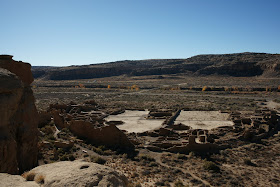
Chaco Canyon National Historical Park is a National Park Service site that contains the largest collection of stone masonry ruins north of Mexico. It dates from about 850 AD to 1250 AD. It was built and populated by people referred to as Anasazi by the Utes and Navajos, which means "enemy ancestors" or "ancient ones." These people are thought to have been the ancestors of modern Pueblo peoples and are also referred to as "ancient or ancestral Puebloans".
Chaco is located in the four corners area of New Mexico southeast of Farmington. It is about 6200 feet elevation. The climate is high desert, with an average of about 9 inches of rain per year. Temperatures range from well below zero in the winter to 102 or so in the summer. Water is not plentiful in this area. Scientists say that the climate has not changed appreciably since the Chacoans setled there. One of the great mysteries to me is why? Why settle here instead of a more hospitable area?
The Anasazi culture included the Mesa Verde, Betatakin, Aztec, Hovenweep, and Canyon de Chelly villages and people. Chaco Canyon with its villages, called Great Houses, numerous kivas and dwellings is thought to be the religious and trading center of the Anasazi people. They built genuine roads out from Chaco. Trade goods from Mexico-Central America have been found, including macaws, copper bells, etc. Traces of cacao have also been found.
No one knows for sure why they abandoned these settlements and moved on, but the most common explanation is a 50 year drought that started in 1130 AD. The modern Pueblo people have oral traditions about their journey away from Chaco. They also regard the ruins as sacred; the Zuni and Laguna people return on the summer solstice for dances and ceremonies.
The ruins show evidence of master planning and fairly sophisticated engineering. The tallest part of the structure appears to have been 5 stories high. There is evidence that they made astronomical observations of the solstices, equinoxes and lunar cycles. The Great House at Pueblo Bonito is laid out with the straight front wall on the east-west axis and bisected by a north-south wall. The GreatHouses are generally laid out this way and some also on either the east-west axis or the north -south axis leading to Pueblo Bonito.

Above is a photo of Pueblo Bonito take from the mesa/cliff behind it. You can see the D shape of this 650 room structure and its two axes, north-south and east-west. You can also see the many kivas in this pueblo.

The photo above is the first part of the trail to the top of the cliff, through the talus at the bottom of the cliff. Part way up you get into a crack which takes you to the top, and is much easier than the bottom talus. The two photos below are in the crack.


Below is a photo of walls and rooms at the southeast corner of Pueblo Bonito.

The photo below shows a corner door. There are seven of these in Pueblo Bonito. Architects say this is supposed to weaken the walls. I suppose that may be true, but these have been there about 1000 years. The wood is original.

Below is a photo of an original ceiling at Pueblo Bonito.

Below is an unusual "keyhole" door at Pueblo Bonito.

Typical masonry with a beam sticking out is shown below. The mortar is mud. Timber was brought to Chaco from as far as 50 miles away, such as from the Chuska mountains or the Mt. Taylor region.

Below is the great kiva at Casa Rinconada, directly south of the wash from Pueblo Bonito. I believe this is the largest known kiva in the southwest. Four huge tree trunks held up the roof. 3-400 people could be in this kiva for a meeting or a ceremony. According to current scientific thought, the kivas were deroofed and any contents removed by the Chacoans when they were abandoned. Some were apparently burned.

At the Great House of Chetro Ketl there are the remains of colonnades along one wall, shown below. The spaces between were filled later for some reason or another. The nearest colonnades were constructed by the Toltecs in Mexico or Central America.

Chaco Canyon is one of the most interesting places I have ever been. The first time we went there as a family we camped about three feet from a ruin wall. There are many unanswered questions about this place which we are probably not going to get answers for, at least in this life.













































